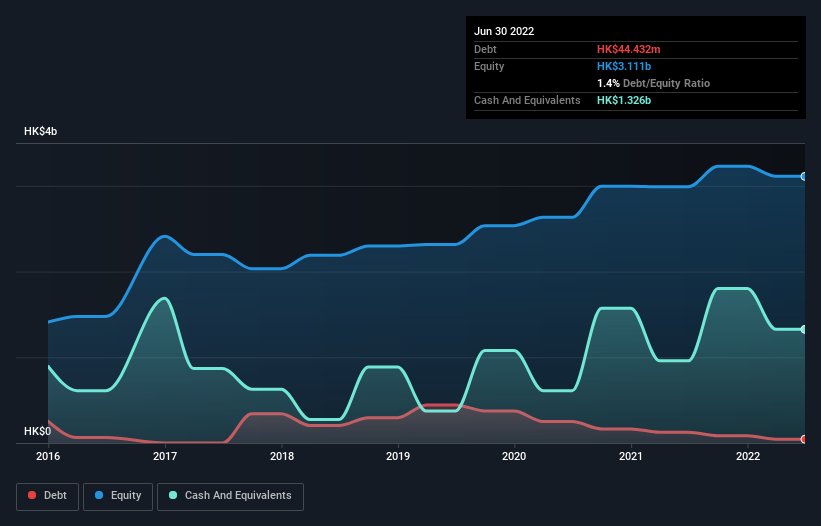[ad_1]
Howard Marks put it nicely when he said that, rather than worrying about share price volatility, ‘The possibility of permanent loss is the risk I worry about… and every practical investor I know worries about.’ So it might be obvious that you need to consider debt, when you think about how risky any given stock is, because too much debt can sink a company. We can see that Sundart Holdings Limited (HKG:1568) does use debt in its business. But the real question is whether this debt is making the company risky.
What Risk Does Debt Bring?
Debt and other liabilities become risky for a business when it cannot easily fulfill those obligations, either with free cash flow or by raising capital at an attractive price. If things get really bad, the lenders can take control of the business. However, a more usual (but still expensive) situation is where a company must dilute shareholders at a cheap share price simply to get debt under control. Of course, plenty of companies use debt to fund growth, without any negative consequences. When we examine debt levels, we first consider both cash and debt levels, together.
Check out our latest analysis for Sundart Holdings
What Is Sundart Holdings’s Debt?
As you can see below, Sundart Holdings had HK$44.4m of debt at June 2022, down from HK$124.6m a year prior. However, it does have HK$1.33b in cash offsetting this, leading to net cash of HK$1.28b.

A Look At Sundart Holdings’ Liabilities
Zooming in on the latest balance sheet data, we can see that Sundart Holdings had liabilities of HK$3.00b due within 12 months and liabilities of HK$3.41m due beyond that. On the other hand, it had cash of HK$1.33b and HK$4.05b worth of receivables due within a year. So it can boast HK$2.38b more liquid assets than total liabilities.
This surplus strongly suggests that Sundart Holdings has a rock-solid balance sheet (and the debt is of no concern whatsoever). On this view, lenders should feel as safe as the beloved of a black-belt karate master. Succinctly put, Sundart Holdings boasts net cash, so it’s fair to say it does not have a heavy debt load!
The modesty of its debt load may become crucial for Sundart Holdings if management cannot prevent a repeat of the 28% cut to EBIT over the last year. Falling earnings (if the trend continues) could eventually make even modest debt quite risky. The balance sheet is clearly the area to focus on when you are analysing debt. But ultimately the future profitability of the business will decide if Sundart Holdings can strengthen its balance sheet over time. So if you want to see what the professionals think, you might find this free report on analyst profit forecasts to be interesting.
Finally, while the tax-man may adore accounting profits, lenders only accept cold hard cash. Sundart Holdings may have net cash on the balance sheet, but it is still interesting to look at how well the business converts its earnings before interest and tax (EBIT) to free cash flow, because that will influence both its need for, and its capacity to manage debt. Happily for any shareholders, Sundart Holdings actually produced more free cash flow than EBIT over the last three years. That sort of strong cash conversion gets us as excited as the crowd when the beat drops at a Daft Punk concert.
Summing Up
While we empathize with investors who find debt concerning, the bottom line is that Sundart Holdings has net cash of HK$1.28b and plenty of liquid assets. And it impressed us with free cash flow of HK$521m, being 109% of its EBIT. So is Sundart Holdings’s debt a risk? It doesn’t seem so to us. The balance sheet is clearly the area to focus on when you are analysing debt. But ultimately, every company can contain risks that exist outside of the balance sheet. For instance, we’ve identified 3 warning signs for Sundart Holdings (1 is potentially serious) you should be aware of.
If you’re interested in investing in businesses that can grow profits without the burden of debt, then check out this free list of growing businesses that have net cash on the balance sheet.
Have feedback on this article? Concerned about the content? Get in touch with us directly. Alternatively, email editorial-team (at) simplywallst.com.
This article by Simply Wall St is general in nature. We provide commentary based on historical data and analyst forecasts only using an unbiased methodology and our articles are not intended to be financial advice. It does not constitute a recommendation to buy or sell any stock, and does not take account of your objectives, or your financial situation. We aim to bring you long-term focused analysis driven by fundamental data. Note that our analysis may not factor in the latest price-sensitive company announcements or qualitative material. Simply Wall St has no position in any stocks mentioned.
[ad_2]
Source link







